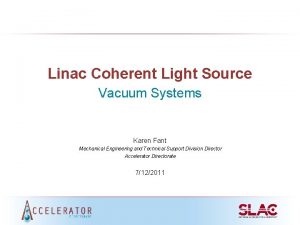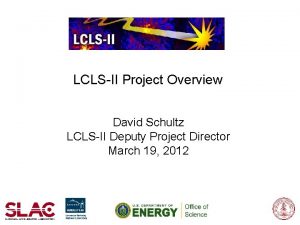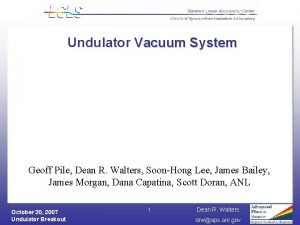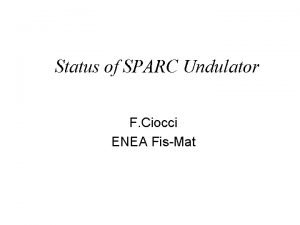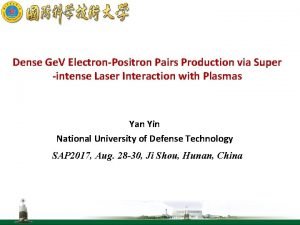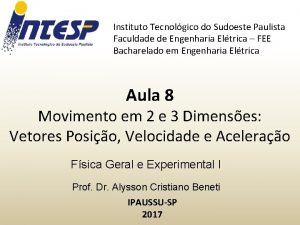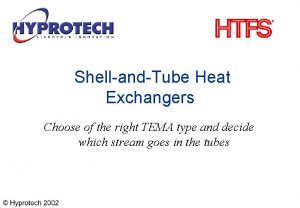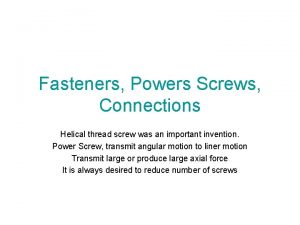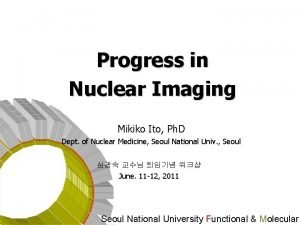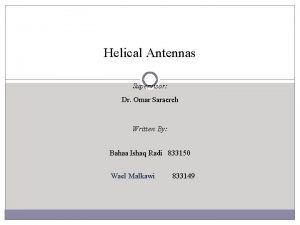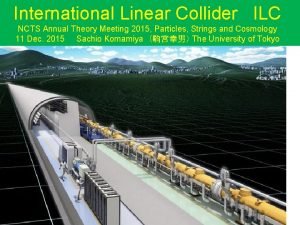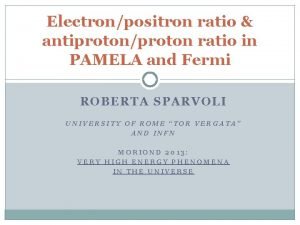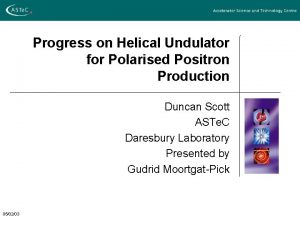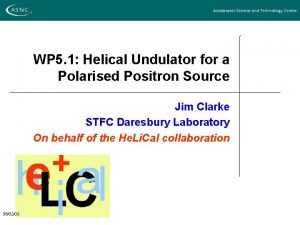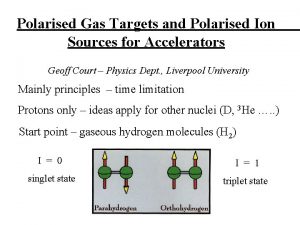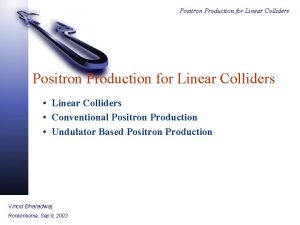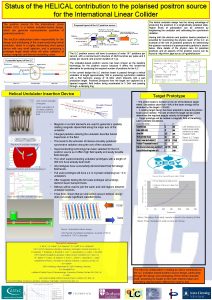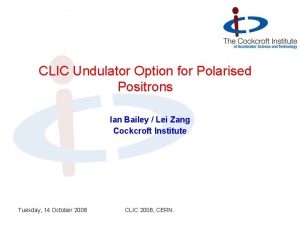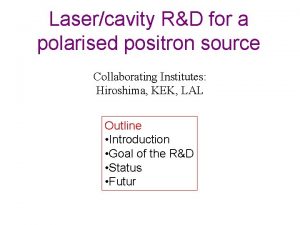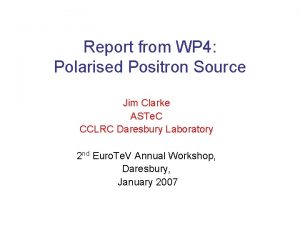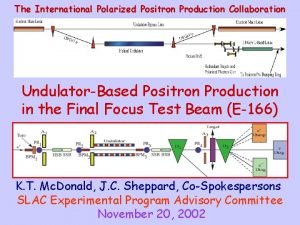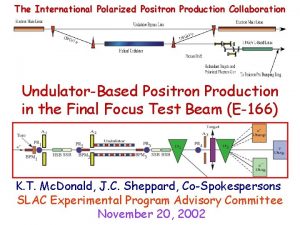A Helical Undulator for Polarised Positron Production Duncan














- Slides: 14

A Helical Undulator for Polarised Positron Production Duncan Scott ASTe. C Daresbury Laboratory CCLRC (Ph. D Student University of Liverpool Physics Department) 05/02/03

Contents l l l Conventional positron production Undulator based positron production Polarised positron production Undulator designs (Some) Issues l Vacuum l Magnetic Field Measurements l Wakefields l Field Enhancement with Iron l Synchrotron Radiation Summary 03/09/04 Duncan Scott: ECFA Durham Workshop 2

‘Conventional’ Positron Production- SLC at SLAC l ~30 Ge. V electrons hit a thick target l Fundamental positron intensity limit given by thermal stress in the target due to the energy deposited by the primary electrons l SLC operates close to stress limits An extension of this technology by two orders of magnitude seems unrealistic l 03/09/04 Positron Flux (e+ s-1) Duncan Scott: ECFA Durham Workshop SLC TESLA (3 ~ 6) x 1012 ~3 x 1014 3

Undulator Based Positron Production l l Pair production cross section peaks at ~20 Me. V Would like to create 20 Me. V photons with a 250 Ge. V electron beam 03/09/04 Duncan Scott: ECFA Durham Workshop 4

What is an Undulator? l l l Undulators create an on-axis periodic magnetic field This causes the beam to “undulate” through the device At each deflection photons are emitted We can think of an undulator like diffraction grating Gives rise to interference effects at an observer – high photon intensity 03/09/04 Duncan Scott: ECFA Durham Workshop 5

Polarised Positrons (V. E. Balakin & A. A. Mikhailichenko, 1979) l l A ‘Helical Undulator’ would provide Circularly Polarised photons These could produce Polarised Positrons (a possible upgrade path for TESLA, NLC day one) Helical Field -Rotating dipole field in the transverse planes e- beam follows a helical path Circularly Polarised Photons 03/09/04 Duncan Scott: ECFA Durham Workshop 6

l l Undulator Design: Current Choices Need a short period l l l – more periods – more photons – more positrons Two designs (from many) l l 14 mm period ~4 mm beam aperture ~140 m long Super-Conducting Bifilar helix 03/09/04 l ‘Ring undulator’ (Klaus Halbach NIM Vol. 187, No 1) Duncan Scott: ECFA Durham Workshop 7

The Models l. Model are being made to compare the technologies l l l 03/09/04 Double helix cut into tube Ribbon wire used to wind one “layer” of sc wire at a time End jig used to return wire along the second helix Bore to be made using same technology as rifle making Permanent Magnet option has 8 blocks per ring 8 rings period Rings split in half to allow access to vacuum vessel Duncan Scott: ECFA Durham Workshop 8

Issues: Vacuum Problems l l To achieve 10 -8 m. Bar at room temperature will require a NEG coated vessel No-one has ever NEG coated a 4 mm circular aperture vessel Vacuum Science R&D required Other possibilities l Cool down PPM to ~140 K? l Would this help the vacuum problem? (Water would freeze) l Increase the on-axis magnetic field? (enable a shorter period to be used? ) 03/09/04 Duncan Scott: ECFA Durham Workshop 9

Issues: Measuring the Magnetic Field l l Accurate position/magnetic field measurements characterises the undulator radiation However we have to: Measure field in a ~4 mm circular aperture l Limit of smallest commercial Hall probe Measure position & field at ~4 K l Requires fully calibrated cryogenic magnet measurement system 03/09/04 Duncan Scott: ECFA Durham Workshop 10

Issues: Resistive Wall Wakefields l l l Expressions for resistive wall wakefields in finite conducting finite thickness multilayer tubes? (vessel & NEG Coating) l l These will cause changes in total energy and induce an energy spread Table shows values for ‘single layer’ tube Vessel Material Longitudinal Energy Losses (Me. V) Spread l l l Thin NEG Coating Vessel Material Transverse Losses (Ge. V m-1) Aluminium 44 1. 8 10 -4 1. 9 Stainless Steel 253 8. 8 10 -4 7. 8 What are the effects of the surface roughness of the NEG coating? What is the emittance degradation? Calculations based on anomalous skin effect for SC magnet? 03/09/04 Duncan Scott: ECFA Durham Workshop 11

Issues: Effects of Iron (2 D modelling) l Iron can be added in to improve the field strength – but how? e- 03/09/04 l Iron sleeve – increases field ~5% l Iron sleeve and iron between windings– increases field ~40% l Totally iron former – increases field ~20% Duncan Scott: ECFA Durham Workshop 12

Issues: Power Dissipated due to Synchrotron Radiation l l Undulator modelled in 2 m sections with 1 m gap between sections Calculated power deposited in each section due to synchrotron radiation produced in previous sections 1 m 1 2 4 5 r = 2 mm 2 m l l l 03/09/04 50 Ge. V, 150 Ge. V, 250 Ge. V Photon beam collimation will be needed – smallest aperture in machine? (No near-field expression for synchrotron radiation from Helical Undulator) Duncan Scott: ECFA Durham Workshop 13

Summary l l l Undulator based positron source can provide the required positron flux Can also provide polarised positrons 2 models based on SC and PPM technology are being built Entire magnet (140 m+) pushes the limits for engineering design and construction of PPM and SC undulator magnets Further work: l NEG coating vessels? l Accurate measurement of magnetic fields/position for low temperature and small aperture magnets? l Wakefield effects? l Increase on-axis field with iron or operation at lower temperatures? l Effects of SR on vacuum, power deposited, … etc. 03/09/04 Duncan Scott: ECFA Durham Workshop 14

